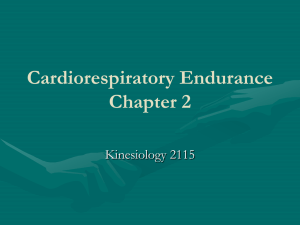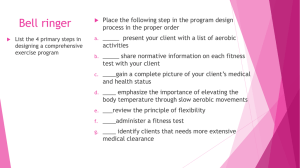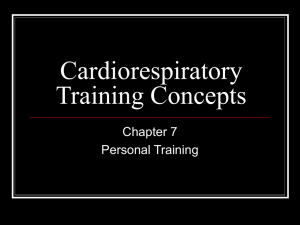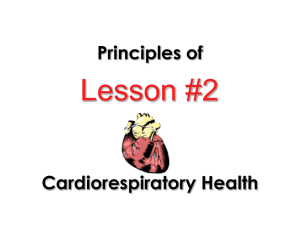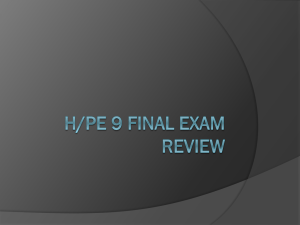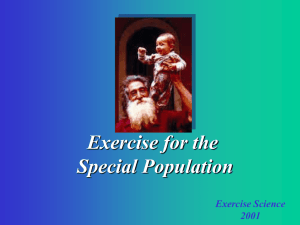Physiological Adaptations to Cardiorespiratory Exercise
advertisement
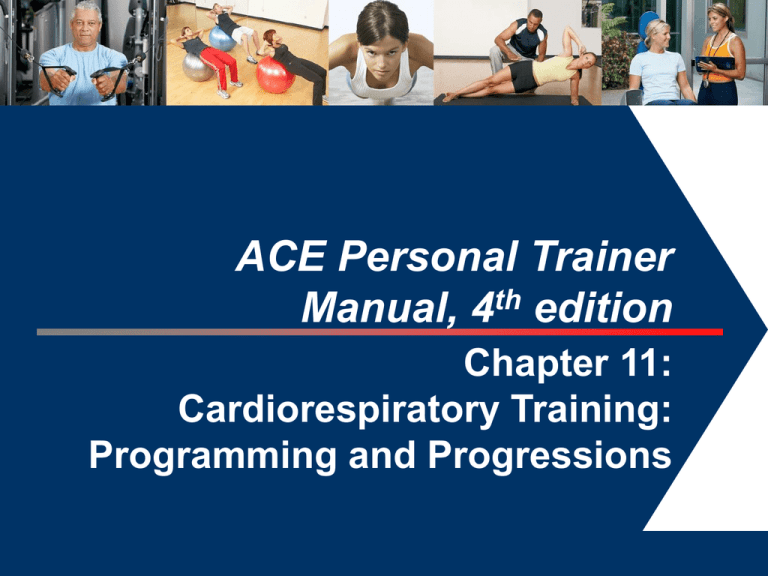
ACE Personal Trainer Manual, 4th edition Chapter 11: Cardiorespiratory Training: Programming and Progressions 1 Physiological Adaptations to Cardiorespiratory Exercise Muscular system – Type I muscle fibers (low- to moderate-intensity exercise) – Mitochondria – Capillaries – Type II muscle fibers (high-intensity exercise) Physiological Adaptations to Cardiorespiratory Exercise (cont.) Cardiovascular system – With endurance training, the heart muscle will hypertrophy, enlarging its chambers and becoming a bigger and stronger muscle. – Increased cardiac output • Primarily due to a larger stroke volume • A redistribution of the cardiac output to the active muscles (via vasodilation) may also improve after training. Physiological Adaptations to Cardiorespiratory Exercise (cont.) Respiratory system – Alveoli • The structure in the respiratory system that interfaces with the cardiovascular system. – More efficient muscles of respiration • Diaphragm • Intercostals • Muscles that pull the ribcage upward during active inspiration • Muscles that pull the ribcage downward during active expiration – Increased tidal volume Time Required for Increases in Aerobic Capacity Cardiovascular adaptations are usually measureable after a couple of weeks of training. VO2max – Increases with training, but reaches a peak and plateaus within about six months Ventilatory threshold (VT) – A significant marker of metabolism that permits prediction of lactate threshold (LT) during progressive exercise – May continue to increase for years with continued training, as illustrated on the following slide Schematic of Changes in VO2max and Metabolic Markers Steady-state and Interval-based Exercise Steady state – Consistent intensity of exercise where the energy and physiological demands are met by the delivery from the physiological systems – Limited by the willingness to continue or the availability of oxygen, muscle glycogen, and/or blood glucose Interval training – Higher-intensity exercise followed by recovery periods – Provides anaerobic adaptations that improve tolerance for the buildup of lactic acid (lactate threshold) – Provokes an increase in stroke volume that is not achievable with lower-intensity steady-state training Components of a Cardiorespiratory Workout Session Warm-up – A period of lighter exercise preceding the conditioning phase of the exercise bout – Should last for five to 10 minutes for most healthy adults – Should not be so demanding that it creates fatigue that would reduce performance. – Stretching • The practice of stretching before performing any warm-up is not justified and may potentially be harmful. – May be subdivided into a general cardiovascular warm-up followed by a more exercise- or event-specific dynamic warm-up. Components of a Cardiorespiratory Workout Session (cont.) Conditioning phase – The higher-intensity elements of a session should take place fairly early in the conditioning phase of the workout. – Cardiovascular drift during steady-state training • A gradual increase in heart-rate response during a steady-state bout of exercise – Aerobic-interval training exercise-to-recovery ratios between 1:2 and 1:1 – “Lactate sinks” • Aerobically trained type II muscle fibers that are proficient at using lactate for energy during hard steady-state exercise Components of a Cardiorespiratory Workout Session (cont.) Cool-down – Should be of approximately the same duration and intensity as the warm-up – Five to 10 minutes of low- to moderate-intensity activity – “Muscle pump” – An active cool-down can help remove metabolic waste from the muscles so that it can be metabolized by other tissues. – A stretching routine following the cool-down period is appropriate. Cardiorespiratory Exercise for Health, Fitness, and Weight Loss Most health benefits occur with at least 150 minutes a week of moderate-intensity physical activity. ACSM and AHA F.I.T.T. guidelines are widely accepted. Additionally, clients should always enjoy the exercise experience. Changes in fitness are more sensitive to modifications in intensity than to modifications in the frequency or duration of training. Monitoring Intensity Using Heart Rate Numerous variables impact MHR: – Genetics – Exercise modality – Medications – Body size • MHR is generally higher in smaller individuals who have smaller hearts, and hence lower stroke volumes. – Altitude • Altitude can lower the MHR reached. – Age • MHR does not show a consistent 1-bpm drop with each year in all individuals. Estimated Heart Rate Formulas Estimated MHR formulas (three formulas): – MHR = 220 – age • Standardized predicted MHR formula used in fitness for decades • Standard deviation (s.d.): +/- 12 bpm (+/- 36 bpm at 3 s.d.) – MHR = 208 – (0.7 x Age) • s.d. close to +/- 7 bpm (+/- 21 bpm at 3 s.d.) – MHR = 206.9 – (0.67 x Age) • s.d. close to +/- 7 bpm (+/- 21 bpm at 3 s.d.) Accurate programming with MHR requires actual MHR – Impractical for the vast majority of clients and trainers Monitoring Intensity Using Heart Rate Reserve (HRR) Heart-rate reserve (HRR) equals the difference between MHR and RHR – HRR = MHR – RHR – Target HR (THR) = the desired HR during exercise – The Karvonen formula can be used to calculate THR as a percentage of HRR: THR = (HRR x % Intensity) + RHR Accurate programming with HRR requires actual MHR and RHR – Actual MHR is impractical for the majority of clients and trainers ACSM Guidelines for Using %MHR Monitoring Intensity Using Ratings of Perceived Exertion Two versions of the RPE scale: – Classical (6 to 20) scale – More contemporary category ratio (0 to 10) scale Both scales are capable of defining ranges of objective exercise intensity associated with effective exercise training programs. Monitoring Intensity Using VO2 Intensity can be monitored as a %VO2max or %VO2R – Training based on metabolic or ventilatory responses is much more meaningful than using arbitrary ranges of %VO2max or %VO2R, especially when these values are predicted. – Training intensities that are too far below the first ventilatory threshold (VT1) yield minimal cardiorespiratory fitness benefits. Submaximal assessments that predict VO2max generally use predicted MHR – Errors in predicted MHR will affect predicted VO2max Monitoring Intensity Using METS METs – Multiples of an assumed average metabolic rate at rest of 3.5 mL/kg/min • Resting metabolic rate is not exactly 3.5 mL/kg/min in every individual. – The utility of using METs is so substantial that it more than makes up for any imprecision • Exercising at 5 METs equates to working 5x greater than when at rest – 5 MET x 3.5 mL/kg/min = 17.5 mL/kg/min Monitoring Intensity Using Caloric Expenditure When the body burns fuel, O2 is consumed, which yields calories to perform work. – 5 kcal per liter of O2 Absolute VO2 (L/min) Relative VO2 (mL/kg/min) Commercial cardiovascular exercise equipment – Provide estimates of caloric expenditure using absolute VO2 based on the amount of work being performed – Kcal per exercise session = L/min x 5 kcal/L x minutes Online caloric-expenditure calculators are available for a variety of physical activities on the ACE website. – www.acefitness.org/calculators Problem Solving Thelma’s caloric expenditure: VO2max = 37.08 ml/kg/min. Caloric Expenditure (kcal/min) Multiply the VO2 value in ml/kg/min by the client’s weight in kilograms. VO2 x body weight in kilograms(kg) – Thelma’s weight: 65.9kg You will be left with a VO2 value in ml/min. 2443.6 ml/min. Divide this value by 1,000 to convert VO2 to L/min. 2.44 L/min. VO2 (in ml/min) / 1,000 Take this Value and multiply by 5kcal/L. 12.2 kcal/min. (1) For every Liter of Oxygen consumed, you burn 5 kcal (calories) (2) You now have Calories burned/minute (a) Multiply by 60 for Calories burned/hour (b) Multiply by number of minutes exercised or exercising for. 180 calories burned in 14 minutes and 45 seconds. Monitoring Intensity Using the Talk Test Ventilation increases as exercise intensity increases – Linear increase, with the exception of two distinct deflection points: VT1 & VT2 Initially, increased ventilation is accomplished through increased inspiration (tidal volume) At about the intensity of VT1, the increase in ventilation is accomplished by an increase in breathing frequency (respiration rate) Above VT1, but below the second ventilatory threshold (VT2), speaking is possible, but not comfortable. VT2 represents the point at which high-intensity exercise can no longer be sustained. – Onset of blood lactate accumulation (OBLA) – Above VT2, speech is not possible, other than single words. The talk test is an index of exercise intensity at VT1. Monitoring Intensity Using Blood Lactate and VT2 The metabolic response to exercise is generally non-linear. – It is more reasonable to program exercise in terms of metabolic response. – Easily marked by either blood lactate or VT1 and VT2 Blood lactate threshold and VT1 – Bicarbonate buffering system OBLA, HR turnpoint (HRTP), and VT2 – HRTP is a flattening of the heart-rate response to increasing intensity. Three-zone Training Model Zone 1 – Relatively easy exercise – Reflects heart rates below VT1 – Client can talk comfortably Zone 2 – Reflects heart rates from VT1 to just below VT2 – Client is not sure if he or she can talk comfortably Zone 3 – Reflects heart rates at or above VT2 – Client definitely cannot talk comfortably Cardiorespiratory Exercise Duration Benefits gained from exercise and physical activity are dose-related. – Greater benefits are derived from greater quantities of activity. – Physical activity expending ≤1,000 kcal/week generally only produces improvements to health. – Expending ≥2,000 kcal/week promotes effective weight loss and significant improvements to overall fitness. Beginner exercisers – Typically cannot tolerate 30 minutes of moderate-intensity activity – Generally cannot start with the recommended frequency Cardiorespiratory Exercise Progression Progression follows basic training principles, including: – Overload – Specificity Exercise duration is the most appropriate variable to manipulate initially. Thereafter, implement progressions by increasing exercise frequency and then exercise intensity. Fartlek training Types of Cardiorespiratory Exercise Physical activities that promote improvement or maintenance of cardiorespiratory fitness: • Equipment-based cardiovascular exercise • Group exercise • Circuit training • Seasonal exercise • Water-based exercise • Mind-body exercise • Lifestyle exercise • Outdoor exercise Physical Activities That Promote Improvement or Maintenance of Cardiorespiratory Fitness Exercise Description Recommended Groups Activity Examples Endurance activities requiring minimal skill or fitness All adults Walking, slow-dancing, recreational cycling or swimming Vigorous-intensity endurance activities requiring minimal skill Adults participating in regular exercise or having better than average fitness Jogging, rowing, elliptical training, stepping, indoor cycling, fast-dancing Endurance activities requiring higher skill levels Adults with acquired skill and higher fitness levels Swimming, cross-country skiing Recreational sports Adults participating in regular training with acquired fitness and skill levels Soccer, basketball, racquet sports Equipment-based Cardiovascular Exercise The aerobic value of any equipment-based program is based on how the machine is used. – Sustained moderate-intensity exercise is the foundation of cardiorespiratory exercise training. Many pieces can estimate the MET or caloric cost of exercise. – Common sense is required when using the MET or caloric values generated by exercise equipment. – In less-fit individuals, and if handrail support is used, the values may overestimate the actual value attained. Group Exercise During the past few decades, an enormous variety of group exercise formats has emerged. Common to most formats is the use of music. The choreography and intensity can vary greatly. – Group indoor cycling programs can elicit VO2 or HR values greater than those achieved during exercise tests. – Group exercise designed for older individuals can be very low intensity. Circuit Training Cardiorespiratory training effects can be observed during circuit training by: – Alternating muscular strength and endurance activities with classical aerobic training – Performing the activities in a rapid sequence Depending on equipment availability, circuit training can be performed by: – A single individual rotating through select exercises – Groups of participants rotating in an organized manner through several exercise stations Outdoor and Seasonal Exercise Outdoor exercise activities – Have emerged out of recreational activities, many with the promise of providing cardiorespiratory fitness – Some activities are much more variable in their cardiorespiratory training effects. Seasonal exercise activities – Likely to have a large cardiorespiratory training effect if the activities require sustained physical activity • Cross-country skiing and snowshoeing in the winter months and walking and running in the warmer months Water-based Exercise Water aerobics classes and games can be effective methods of exercise. Water-based exercise is particularly valuable for older or obese individuals or those with orthopedic issues. Energy cost of ambulatory activity in the water Immersion in water causes the blood to be redistributed to the central circulation. Mind-body and Lifestyle Exercise Mind-body exercise – Generally not associated with high-intensity aerobic activity – May provide an intensity comparable to that of walking – Examples include Pilates, hatha yoga, Nia, and tai chi Lifestyle exercise – Consistently performed domestic activities can provide enough stimulus to make previously sedentary people fit and contribute to excellent health. – Activities like yard work should be viewed in the context of the total exercise load. ACE IFT Model Cardiorespiratory Training Phases The ACE IFT Model has four cardiorespiratory training phases: Phase 1 Phase 2 AEROBIC-BASE AEROBIC-EFFICIENCY Phase 3 Phase 4 ANAEROBIC- ANAEROBIC- ENDURANCE POWER Clients are categorized into a given phase based on their current health, fitness level, and goals. – Clients may be in different phases for cardiorespiratory training and functional movement and resistance training. Phase 1: Aerobic-base training The focus is on creating positive exercise experiences that help sedentary clients become regular exercisers. No fitness assessments are required prior to exercise. Focus on steady-state exercise in zone 1 (below VT1). Gauge intensity by the client’s ability to talk comfortably and/or RPE of 3 to 4. Increase exercise duration (<10% increase per week) Progress to phase 2 once client can sustain steady-state cardiorespiratory exercise for 20 to 30 minutes in zone 1 (below talk test threshold; RPE of 3 to 4) and is comfortable with assessments. AEROBIC-BASE TRAINING DURANCE Phase 2: Aerobic-efficiency Training The focus is on increasing the duration of exercise and introducing intervals to improve aerobic efficiency, fitness, and health. Administer the submaximal talk test to determine HR at VT1. Exercise programming in Zone 1 (< VT1) and Zone 2 (VT1 to < VT2) Progressions for Aerobic-efficiency Training: – Increase duration of exercise in zone 1 – Then introduce low zone 2 intervals just above VT1 (RPE of 5) – Progress low zone 2 intervals by increasing the time of the work interval and later decreasing the recovery interval time. – As the client progresses, introduce intervals in the upper end of zone 2 (RPE of 6). Most clients will train in this phase for many years. If a client has event-specific goals or is a fitness enthusiast looking for increased challenges and fitness gains, progress to phase 3. AEROBIC-EFFICIENCY TRAINING Phase 3: Anaerobic-endurance Training The focus is on designing programs to help clients who have endurance performance goals and/or are performing seven or more hours of cardiorespiratory exercise per week. Administer the VT2 threshold test to determine HR at VT2. The majority of cardiorespiratory training time is spent in zone 1, with intervals and higher-intensity sessions focused in zones 2 and 3. Cardiorespiratory training time is distributed as follows: – Zone 1 (< VT1): 70–80% of training time – Zone 2 (VT1 to < VT2): <10% of training time – Zone 3 (> VT2): 10–20% of training time Many clients will never train in phase 3. Only clients who have very specific goals for increasing speed for short bursts at near-maximal efforts will move on to phase 4. AEROBIC AEROBIC ANAEROBIC ANAEROBICENDURANCE TRAINING BASE EFFICIENCY POWER Phase 4: Anaerobic-power Training The focus is on improving anaerobic power to improve phosphagen energy pathways and buffer blood lactate. Programs will have a similar distribution to phase 3 training times in terms of distribution among zones 1, 2, and 3. Zone 3 training will include very intense anaerobic-power intervals that are at or near maximal levels. – Zone 3 intervals in phase 4 will be of shorter duration than in phase 3, due to greater intensity (RPE = 9 or 10) – Increase length of recovery interval during zone 3 interval sessions Clients will generally only work in phase 4 during specific training cycles prior to competition. AEROBIC BASE AEROBIC EFFICIENCY ANAEROBIC ENDURANCE ANAEROBIC-POWER TRAINING Recovery and Regeneration As a general principle, training should be periodized. The biggest programming mistakes include: – Taking too few recovery days – Trying to do something other than recover on recovery days – Trying to progress the training load on recovery days (when it should only be progressed on hard days). The bottom line is that recovery days are for recovery. Two or three hard training days per week are probably adequate to allow progress toward most goals. Cardiorespiratory Training for Youth In youth, there are two primary considerations: – Prevent early overspecialization – Protect against orthopedic trauma from training too much Youth typically perform intermittent activity rather than the more sustained activity that is typical of fitness exercise. For obese youth, structured exercise may be appropriate. – Intensity should be low enough that exercise is fairly comfortable (zone 1). – Since energy expenditure is of primary importance, the duration of exercise should probably progress to an hour or more. Cardiorespiratory Training for Older Adults In older individuals, there are four overriding considerations that dictate modification of the exercise program: – Avoiding cardiovascular risk – Avoiding orthopedic risk – The need to preserve muscle tissue – The rate at which older individuals respond to training Older adults are less tolerant of: – Heavy training loads – Rapid increases in training load – Single-mode exercise – Stop-and-go game-type activities Sarcopenia and low bone mineral density are also concerns for those over 50. Summary Physical activity or structured exercise performed with regularity causes adaptation in the heart, lungs, blood, and muscle tissue and promotes the ability to perform even more exercise. This session covered: – Physiological adaptations to cardiorespiratory exercise – Components of a cardiorespiratory workout session – Cardiorespiratory exercise for health, fitness, and weight loss – Types of cardiorespiratory exercise – ACE IFT Model cardiorespiratory-training phases – Recovery and regeneration – Considerations for youth and older adults


